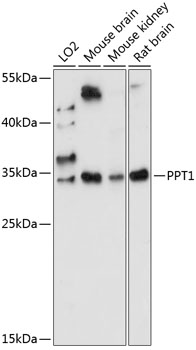Anti-PPT1 Antibody (CAB14769)
- SKU:
- CAB14769
- Product type:
- Antibody
- Reactivity:
- Human
- Mouse
- Rat
- Host Species:
- Rabbit
- Isotype:
- IgG
- Antibody Type:
- Polyclonal Antibody
- Research Area:
- Signal Transduction
Description
| Antibody Name: | Anti-PPT1 Antibody |
| Antibody SKU: | CAB14769 |
| Antibody Size: | 20uL, 50uL, 100uL |
| Application: | WB |
| Reactivity: | Human, Mouse, Rat |
| Host Species: | Rabbit |
| Immunogen: | Recombinant fusion protein containing a sequence corresponding to amino acids 28-306 of human PPT1 (NP_000301.1). |
| Application: | WB |
| Recommended Dilution: | WB 1:500 - 1:2000 |
| Reactivity: | Human, Mouse, Rat |
| Positive Samples: | LO2, Mouse brain, Mouse kidney, Rat brain |
| Immunogen: | Recombinant fusion protein containing a sequence corresponding to amino acids 28-306 of human PPT1 (NP_000301.1). |
| Purification Method: | Affinity purification |
| Storage Buffer: | Store at -20°C. Avoid freeze / thaw cycles. Buffer: PBS with 0.02% sodium azide, 50% glycerol, pH7.3. |
| Isotype: | IgG |
| Sequence: | DPPA PLPL VIWH GMGD SCCN PLSM GAIK KMVE KKIP GIYV LSLE IGKT LMED VENS FFLN VNSQ VTTV CQAL AKDP KLQQ GYNA MGFS QGGQ FLRA VAQR CPSP PMIN LISV GGQH QGVF GLPR CPGE SSHI CDFI RKTL NAGA YSKV VQER LVQA EYWH DPIK EDVY RNHS IFLA DINQ ERGI NESY KKNL MALK KFVM VKFL NDSI VDPV DSEW FGFY RSGQ AKET IPLQ ETSL YTQD RLGL KEMD NAGQ LVFL ATEG DHLQ LSEE WFYA HIIP FLG |
| Gene ID: | 5538 |
| Uniprot: | P50897 |
| Cellular Location: | Lysosome |
| Calculated MW: | 23kDa/34kDa |
| Observed MW: | 33kDa |
| Synonyms: | PPT1, CLN1, INCL, PPT |
| Background: | The protein encoded by this gene is a small glycoprotein involved in the catabolism of lipid-modified proteins during lysosomal degradation. The encoded enzyme removes thioester-linked fatty acyl groups such as palmitate from cysteine residues. Defects in this gene are a cause of infantile neuronal ceroid lipofuscinosis 1 (CLN1, or INCL) and neuronal ceroid lipofuscinosis 4 (CLN4). Two transcript variants encoding different isoforms have been found for this gene. |
| UniProt Protein Function: | PPT1: Removes thioester-linked fatty acyl groups such as palmitate from modified cysteine residues in proteins or peptides during lysosomal degradation. Prefers acyl chain lengths of 14 to 18 carbons. Defects in PPT1 are the cause of neuronal ceroid lipofuscinosis type 1 (CLN1). A form of neuronal ceroid lipofuscinosis with variable age at onset. Infantile, late- infantile, juvenile, and adult onset have been reported. Neuronal ceroid lipofuscinoses are progressive neurodegenerative, lysosomal storage diseases characterized by intracellular accumulation of autofluorescent liposomal material, and clinically by seizures, dementia, visual loss, and/or cerebral atrophy. The lipopigment pattern seen most often in CLN1 is referred to as granular osmiophilic deposits (GROD). Belongs to the palmitoyl-protein thioesterase family. 2 isoforms of the human protein are produced by alternative splicing. |
| UniProt Protein Details: | Protein type:EC 3.1.2.22; Hydrolase; Lipid Metabolism - fatty acid elongation in mitochondria Chromosomal Location of Human Ortholog: 1p32 Cellular Component: axon; cytosol; extracellular region; Golgi apparatus; lipid raft; lysosomal lumen; lysosome; membrane; nucleus; synaptic vesicle Molecular Function:palmitoyl-(protein) hydrolase activity; palmitoyl-CoA hydrolase activity Biological Process: brain development; cofactor metabolic process; cofactor transport; lipid catabolic process; lipid raft organization and biogenesis; lysosomal lumen acidification; negative regulation of apoptosis; negative regulation of cell growth; negative regulation of neuron apoptosis; nervous system development; neuron development; pinocytosis; positive regulation of pinocytosis; positive regulation of receptor-mediated endocytosis; protein depalmitoylation; protein transport; receptor-mediated endocytosis; sphingolipid catabolic process; synaptic transmission Disease: Ceroid Lipofuscinosis, Neuronal, 1 |
| NCBI Summary: | The protein encoded by this gene is a small glycoprotein involved in the catabolism of lipid-modified proteins during lysosomal degradation. The encoded enzyme removes thioester-linked fatty acyl groups such as palmitate from cysteine residues. Defects in this gene are a cause of infantile neuronal ceroid lipofuscinosis 1 (CLN1, or INCL) and neuronal ceroid lipofuscinosis 4 (CLN4). Two transcript variants encoding different isoforms have been found for this gene.[provided by RefSeq, Dec 2008] |
| UniProt Code: | P50897 |
| NCBI GenInfo Identifier: | 1709747 |
| NCBI Gene ID: | 5538 |
| NCBI Accession: | P50897.1 |
| UniProt Secondary Accession: | P50897,Q6FGQ4, B4DY24, |
| UniProt Related Accession: | P50897 |
| Molecular Weight: | 23,094 Da |
| NCBI Full Name: | Palmitoyl-protein thioesterase 1 |
| NCBI Synonym Full Names: | palmitoyl-protein thioesterase 1 |
| NCBI Official Symbol: | PPT1 |
| NCBI Official Synonym Symbols: | PPT; CLN1; INCL |
| NCBI Protein Information: | palmitoyl-protein thioesterase 1 |
| UniProt Protein Name: | Palmitoyl-protein thioesterase 1 |
| UniProt Synonym Protein Names: | Palmitoyl-protein hydrolase 1 |
| Protein Family: | Palmitoyl-protein thioesterase |
| UniProt Gene Name: | PPT1 |
| UniProt Entry Name: | PPT1_HUMAN |







